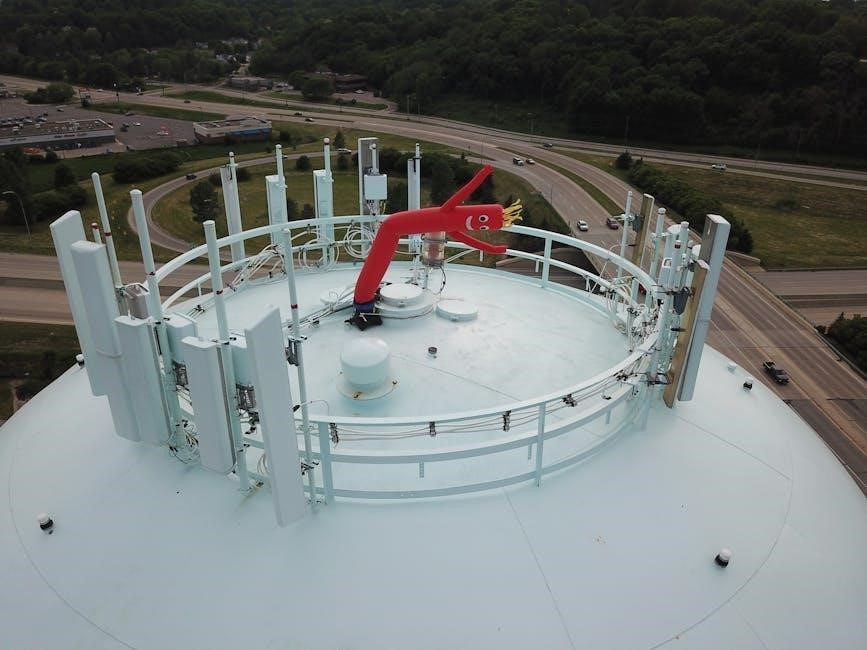Flexible ducts are versatile HVAC components made of flexible materials, ideal for navigating tight spaces. They consist of an inner core, insulation, and an outer jacket, offering ease of installation and noise reduction. These ducts are cost-effective and adaptable, making them popular for various heating and cooling systems. Proper installation is crucial to ensure efficiency and durability, which this guide will address in detail.
1.1 What Are Flexible Ducts?
Flexible ducts are lightweight, adaptable HVAC components designed for air distribution systems. They consist of a flexible inner core, insulation, and an outer protective jacket. The inner core is typically made of plastic or metal, while the insulation reduces heat loss and noise. Flexible ducts are ideal for navigating tight spaces, making them a practical choice for complex HVAC installations. They are commonly used in residential and commercial settings due to their ease of installation and ability to absorb vibrations, reducing noise transmission compared to rigid ducts.
1.2 Benefits of Using Flexible Ducts
Flexible ducts offer numerous advantages, including ease of installation and adaptability to complex spaces. They are lightweight, reducing handling difficulties, and can be bent around obstacles without additional fittings; This minimizes installation time and material costs. Flexible ducts also provide excellent noise reduction due to their insulating properties and ability to absorb vibrations. Their versatility makes them suitable for both new constructions and retrofit projects. Overall, flexible ducts are a cost-effective and efficient solution for modern HVAC systems, balancing performance and convenience effectively.

Planning and Preparation
Planning involves assessing space constraints, measuring duct lengths, and selecting appropriate materials. Proper preparation ensures efficient installation, minimizing potential issues and optimizing system performance.
2.1 Design Considerations for Flexible Duct Systems
When designing flexible duct systems, consider space constraints, airflow requirements, and material compatibility. Avoid direct sunlight exposure and excessive bends to prevent damage. Ensure proper sealing at connections and bends to maintain efficiency. Plan for adequate support to prevent sagging, adhering to manufacturer guidelines. Compliance with HVAC standards like ACCA Manual D is crucial for optimal performance. Properly sizing ducts and minimizing unnecessary length helps reduce friction and energy losses. Always follow local building codes and manufacturer instructions for a safe and efficient system design.
2.2 Tools and Materials Needed for Installation
Key tools for installing flexible ducts include a utility knife, wire brush, tape measure, and metal duct clamps. Essential materials are mastic sealant, aluminum tape, and hanger straps. Gloves and safety goggles are recommended for protection. Ensure compatibility of materials with the duct’s inner core and outer jacket. For insulated ducts, additional insulation materials may be required. Always refer to the manufacturer’s list for specific tools and materials to ensure compliance with installation standards and guarantee a secure, airtight system.
2.3 Understanding Manufacturer Instructions
Manufacturer instructions are crucial for ensuring proper installation and performance of flexible duct systems. These guidelines provide specific details on materials, tools, and techniques, tailored to the duct’s design. Always review the manual before starting, as it outlines safety precautions and compliance requirements. Deviating from recommended procedures can lead to inefficiency, safety risks, or system damage. Compliance ensures optimal performance, energy efficiency, and adherence to HVAC standards. Follow all instructions carefully to guarantee a secure and effective installation.

Installation Process
Installing flexible ducts involves measuring, cutting, and connecting them to vents or rigid ducts. Secure with clamps and seal gaps with tape or mastic for optimal performance.
3.1 Measuring and Cutting Flexible Ducts

Accurate measurement and cutting are essential for proper flexible duct installation. Use a tape measure to determine the required length, marking the duct with a pencil. Cut the duct using a utility knife or specialized tool, ensuring a clean, straight edge. Avoid over-tightening, as this can damage the inner liner. Proper cutting prevents air leaks and ensures smooth airflow. Always follow the manufacturer’s guidelines for handling and cutting the duct material to maintain its integrity and performance. This step sets the foundation for a successful installation.
3.2 Connecting Flexible Ducts to Vents or Rigid Ducts
Connecting flexible ducts to vents or rigid ducts requires precision to ensure airtight seals. Slide the flexible duct over the vent collar or rigid duct, ensuring proper alignment. Secure the connection using a metal clamp, tightening it firmly to prevent air leakage. Apply mastic or aluminum tape to seal any gaps between the duct and the vent or rigid duct. Ensure the connection is snug and free from wrinkles to maintain optimal airflow. Proper connections are critical for system efficiency and long-term performance.
3.3 Bending and Shaping Flexible Ducts
Bending and shaping flexible ducts requires careful handling to maintain their integrity. To avoid damage, extend the duct straight for at least one diameter before making a bend. Avoid sharp bends, as they can restrict airflow or cause kinking. Use wide, smooth curves to ensure proper air circulation. Never bend the duct near connections or vents, as this can weaken the structure. For tighter bends, use tools or supports to maintain shape and prevent sagging. Proper bending techniques ensure optimal airflow and longevity of the duct system.
3.4 Securing Flexible Ducts with Clamps
Securing flexible ducts with clamps ensures a tight, leak-free connection. Metal clamps are recommended for durability and a firm grip. Position the clamp over the duct and vent collar, ensuring it’s centered for even pressure. Tighten the clamp until the duct fits snugly without over-compressing, which could damage the duct. Use clamps at every connection point, including vents, rigid ducts, and bends. Proper clamping prevents air leakage and maintains system efficiency. Regularly inspect clamps to ensure they remain secure, especially in high-traffic or vibration-prone areas.
3.5 Sealing Gaps with Tape or Mastic
Sealing gaps with tape or mastic is essential to prevent air leakage and ensure efficient airflow. Use aluminum tape or mastic to seal all connections, joints, and seams. Apply mastic evenly around the duct edges before connecting them. For insulated ducts, seal the outer vapor jacket with DEC aluminum tape. Ensure no gaps remain, as leaks can significantly reduce system performance. Proper sealing also prevents moisture issues and maintains the integrity of the insulation. Regular inspections and resealing as needed will help maintain optimal system efficiency and longevity.

Supporting Flexible Ducts
Proper support is crucial to prevent sagging and damage. Use hanger straps spaced no more than 4 feet apart, ensuring ducts remain straight and secure for optimal performance.
4.1 Hanger Straps: Materials and Width
Hanger straps are essential for securing flexible ducts. Materials vary by region, but they must be durable and suitable for the duct’s weight. The width of straps should adequately support the duct without causing damage. Straps are typically spaced no more than 4 feet apart to prevent excessive sagging. Properly installed straps ensure the duct remains secure and maintains its shape, preventing damage and ensuring efficient airflow. Always follow manufacturer guidelines for strap selection and installation to meet safety and performance standards.
4.2 Maximum Sag Allowance Between Supports
The maximum sag allowance for flexible ducts between supports is crucial for maintaining efficiency. According to standards, sag should not exceed 1/2 inch per linear foot of duct. Supports should be spaced no more than 4 feet apart to prevent excessive sagging. Proper support ensures even airflow and prevents damage to the duct. Exceeding the sag limit can lead to reduced system performance and potential duct damage. Always adhere to manufacturer guidelines for support spacing to maintain optimal functionality and longevity of the duct system.
4.3 Preventing Sag at Bends
Preventing sag at bends is essential for maintaining airflow efficiency and duct integrity. To avoid sagging, ensure the duct extends straight for at least one duct diameter before making a bend. Use hanger straps or additional supports near bends to prevent drooping. The maximum allowable sag is typically 1/2 inch per linear foot of duct. Supports should be spaced no more than 4 feet apart near bends to maintain structural integrity. Always consult manufacturer guidelines for specific recommendations on handling bends effectively.

Special Installation Scenarios
Special installation scenarios, such as working with insulated systems or unique space constraints, require extra care. Ensure proper handling of insulated ducts and follow splicing techniques for non-insulated sections to maintain efficiency and prevent damage. Always adhere to manufacturer guidelines for these specific cases to achieve optimal performance and longevity of the duct system.
5.1 Installing Flexible Ducts in Insulated Systems
Installing flexible ducts in insulated systems requires careful handling to maintain insulation integrity. Begin by shortening the inner duct to fit the connection point, ensuring it extends at least 50mm. Gently push the inner duct over the area to be connected, then fold back the insulation blanket to expose the connection. Secure the joint using DEC aluminum tape, wrapping it tightly around the duct. This method ensures minimal heat loss and prevents moisture infiltration. Always follow manufacturer guidelines for specific insulated duct systems to guarantee proper installation and efficiency.
5.2 Connecting Insulated Flexible Ducts
Connecting insulated flexible ducts involves precise steps to ensure thermal performance and system efficiency. Begin by shortening the inner duct to the desired length, ensuring it extends at least 50mm beyond the insulation. Slide the inner duct over the connection point and secure it with a metal clamp. Wrap the insulation blanket around the duct, ensuring it covers the entire connection area. Seal any gaps with DEC aluminum tape, applying even pressure to prevent air leakage. This method maintains insulation integrity and prevents heat loss, ensuring optimal system performance and energy efficiency.
5.3 Splicing Non-Insulated Ducts
Splicing non-insulated ducts requires careful preparation to ensure a secure and airtight connection. Begin by trimming excess material from both duct ends and bending the wire ends inward to prevent snagging; Apply mastic to a depth of at least 2 inches inside the duct liner ends. Slide one duct end over a 4-inch metal sleeve, ensuring proper alignment. Secure the connection with a duct clamp and allow the joint to dry completely. This method ensures a durable bond, minimizing air leakage and maintaining system efficiency.
Sealing and Insulating
Proper sealing and insulating are critical for energy efficiency and system performance. Use mastic or aluminum tape to seal gaps, ensuring airtight connections. Insulate flexible ducts to minimize heat loss and prevent moisture condensation, enhancing overall system efficiency and indoor air quality.
6.1 Importance of Proper Sealing
Proper sealing is essential for maintaining HVAC system efficiency and preventing energy loss. Leaks in flexible ducts can lead to reduced airflow, increased energy bills, and compromised indoor air quality. Sealing gaps with mastic or tape ensures airtight connections, minimizing moisture infiltration and contamination. Additionally, a well-sealed system reduces the risk of condensation, which can damage ducts and promote mold growth. Regular inspections and thorough sealing practices are vital for long-term system performance and reliability.
6.2 Sealing the Outer Vapor Jacket
Sealing the outer vapor jacket is critical to prevent moisture infiltration and ensure energy efficiency. Use aluminum tape or mastic to create an airtight seal, following manufacturer guidelines. This step prevents condensation and maintains system performance. Proper sealing also reduces the risk of mold growth and ensures long-term durability. Inspect all seams and connections thoroughly, addressing any gaps or leaks promptly. A well-sealed vapor jacket protects the duct’s insulation and inner core, ensuring optimal airflow and system efficiency while preventing environmental factors from compromising the ductwork’s integrity.
6.3 Insulating Flexible Ducts
Insulating flexible ducts is essential for energy efficiency and maintaining consistent airflow temperatures; Use materials like fiberglass or foam, wrapping them securely around the duct. Ensure insulation is tightly fitted and sealed with appropriate adhesives or tape. Proper insulation reduces heat loss or gain, improving system performance. Follow manufacturer guidelines to achieve optimal results. This step is crucial for minimizing energy consumption and ensuring the HVAC system operates efficiently. Insulation also helps reduce noise from the ducts, enhancing overall comfort and system reliability.

Troubleshooting Common Issues
Common issues with flexible ducts include air leakage, sagging, and bending. Addressing these problems promptly ensures efficient airflow and system longevity. Proper sealing and support can prevent such issues.
7.1 Addressing Air Leakage
Air leakage in flexible ducts can significantly reduce HVAC system efficiency. Common causes include poor connections, improperly sealed joints, or damaged duct surfaces. To address this, inspect all connections and seams. Apply mastic or aluminum tape to seal gaps, ensuring a tight fit. Use duct clamps to secure connections firmly. Additionally, inspect the outer vapor jacket for any tears or punctures and repair them promptly. Regular maintenance and proper installation techniques can prevent air leakage, maintaining optimal airflow and system performance. Addressing leaks early prevents energy loss and enhances overall system reliability.
7.2 Fixing Sagging Ducts
Sagging flexible ducts can impede airflow and reduce system efficiency. To fix this, inspect the duct for improper support or excessive weight. Tighten or replace loose hanger straps, ensuring they are spaced no more than 4 feet apart. If sagging occurs near bends, add additional supports before and after the bend to maintain structural integrity. Avoid over-tightening, as this may damage the duct. Properly securing the ducts restores their shape and ensures smooth airflow, preventing potential damage and maintaining HVAC performance. Regular checks can help prevent sagging issues from recurring.
7.3 Correcting Bent or Damaged Ducts
If a flexible duct is bent or damaged, assess the severity first. For minor kinks, gently straighten the duct without causing further harm. Apply mastic or aluminum tape to seal any cracks or punctures. If the damage is extensive, replace the affected section entirely. Cut the duct cleanly, ensuring smooth edges, and reconnect using a metal sleeve and clamps. Properly seal the joint to prevent air leakage. Always follow manufacturer guidelines for repairs to maintain system efficiency and safety. Regular inspections can help identify issues before they worsen, ensuring optimal HVAC performance.

Maintenance and Upkeep
Regular inspections and cleaning are essential to maintain flexible duct performance. Inspect for damage, dust buildup, and leaks. Clean ducts annually and replace damaged sections promptly to ensure efficiency and safety.
8.1 Routine Inspection of Flexible Ducts
Routine inspections of flexible ducts are crucial to ensure optimal performance and longevity. During inspections, check for visible damage, such as cracks, tears, or crushed areas. Look for signs of sagging or improper support, which can lead to reduced airflow and system inefficiency. Additionally, inspect connections and clamps for tightness to prevent air leaks. Insulation integrity should also be verified to maintain energy efficiency. Regular visual checks can help identify issues early, preventing costly repairs and ensuring the duct system operates efficiently.
8.2 Cleaning Flexible Ducts
Cleaning flexible ducts is essential to maintain airflow efficiency and indoor air quality. Use a soft-bristle brush or vacuum cleaner to remove dust and debris from the inner core. For deeper cleaning, insert a cleaning rod with a brush attachment to scrub the duct’s interior. If mold or mildew is present, clean with a mild detergent solution, but avoid harsh chemicals that could damage the duct material. After cleaning, ensure the duct is completely dry to prevent moisture buildup and mold growth. Regular cleaning prevents contamination and extends the duct’s lifespan.
8.4 Replacing Damaged Sections
To replace damaged sections of flexible ducts, first shut off the HVAC system. Inspect the duct for tears, kinks, or punctures. Cut out the damaged portion using a utility knife, ensuring clean edges. Install a new section, aligning it properly with the existing duct. Secure it with duct clamps and seal gaps with mastic or aluminum tape. Tighten clamps firmly to prevent air leaks. Ensure the repair is airtight to maintain system efficiency. Regular inspections can help identify damage early, preventing costly repairs and ensuring optimal performance; Always follow manufacturer guidelines for replacement materials and techniques.

Safety Precautions
Always handle flexible ducts with care to avoid damage. Wear protective gear like gloves and safety glasses. Ensure proper ventilation and avoid exposure to harmful environmental factors. Follow manufacturer guidelines for safe installation and material handling to prevent accidents and ensure a secure working environment.
9.1 General Safety Guidelines
When installing flexible ducts, prioritize safety to avoid accidents and ensure a secure working environment. Always wear protective gear, including gloves and safety glasses, to prevent injuries. Handle materials carefully to avoid damage and potential hazards. Ensure proper ventilation in the workspace to prevent exposure to harmful substances. Follow manufacturer guidelines for safe installation practices and material handling. Secure the work area to prevent tripping or falling hazards. Adhere to local safety regulations and codes to minimize risks; Proper safety measures ensure a smooth and efficient installation process.
9.2 Avoiding Damage from Environmental Factors
Protect flexible ducts from environmental factors that could cause damage. Exposure to direct sunlight, moisture, or extreme temperatures can degrade materials over time. Use UV-resistant coverings for outdoor installations to prevent cracking or fading. In areas prone to pests, seal entry points to avoid infestation. Avoid installing ducts in environments with high chemical concentrations, as this can corrode the outer jacket. Ensure proper drainage and ventilation to prevent mold growth. Regular inspections can help identify and address potential environmental damage early, ensuring long-term durability and performance of the duct system.
9.3 Handling Materials Safely
Handling flexible duct materials safely is essential to prevent damage and ensure a secure installation. Always wear protective gloves and eyewear when cutting or bending ducts. Use proper lifting techniques to avoid straining or damaging the duct. Store materials in a dry, cool environment away from direct sunlight or harsh chemicals. Avoid dragging ducts across rough surfaces, as this can cause tears or abrasions. Use appropriate tools for cutting and shaping to prevent accidental cuts or punctures. Proper handling ensures the integrity of the ducts and promotes a safe working environment during installation.
Proper installation of flexible ducts ensures efficient HVAC performance, durability, and safety. Follow guidelines, use quality materials, and maintain systems regularly for optimal results and long-term satisfaction.
10.1 Summary of Key Installation Steps
Proper installation of flexible ducts begins with precise planning and preparation. Measure and cut the ducts accurately, ensuring minimal waste. Connect the ducts to vents or rigid ducts using appropriate clamps and seals. Bending and shaping should be done carefully to avoid damage. Secure the ducts with clamps and supports, ensuring no excessive sagging. Seal all gaps with mastic or tape to prevent air leakage. Follow manufacturer guidelines for specific materials and configurations. Regular maintenance and inspections are essential to maintain efficiency and longevity. Proper installation ensures optimal HVAC performance and durability.
10.2 Final Tips for Successful Installation
For a successful flexible duct installation, ensure all connections are tightly sealed to prevent air leakage. Use recommended tools and materials to maintain duct integrity. Avoid excessive bending or sagging by following support guidelines. Plan the duct layout to minimize unnecessary bends and extensions. Always refer to the manufacturer’s instructions for specific product requirements. Regularly inspect and maintain the system to ensure optimal performance. Proper installation practices will enhance energy efficiency, reduce noise, and extend the lifespan of your HVAC system.

Manufacturer Instructions and Compliance
Always adhere to manufacturer guidelines for flexible duct installation to ensure compliance with HVAC standards and optimal system performance. Proper installation techniques guarantee efficiency and safety.
11.1 Following Manufacturer Guidelines
Following manufacturer guidelines is essential for proper flexible duct installation. These instructions ensure compliance with industry standards and optimize system performance. Always review the manufacturer’s manual before starting the installation. Specific steps, such as trimming excess material, bending wires, and applying adhesives, must be executed as directed. Use recommended tools and materials to avoid damaging the duct. Proper clamping and sealing techniques are critical to prevent air leakage and ensure efficiency. Adhering to these guidelines guarantees a safe and effective installation, aligning with HVAC standards and maintaining warranty validity. Compliance ensures long-term durability and reliable system operation.
11.2 Compliance with HVAC Standards
Compliance with HVAC standards is critical for ensuring safe and efficient flexible duct installations. Standards like AS 4254.1:2021 and ACCA guidelines provide detailed requirements for duct sizing, installation, and performance. Proper sealing, sag limits, and material specifications must be adhered to. Regular inspections and testing ensure systems meet safety and efficiency benchmarks. Compliance also involves following local building codes and regulations. By adhering to these standards, installations achieve optimal airflow, reduced energy consumption, and long-term durability. Always verify that materials and methods align with current HVAC standards for a reliable and efficient system performance.